- Getting around Lijiang. Dont stay in the Old Towns more than 2 days, there is nothing to do. KRISS Oct 9, 2013 05:46
- 2013 Beijing Temple Fair BENNYLAU Feb 26, 2013 03:29
- Malaysian traveling from KUL - LAX vis Shanghai PVG ZATI_DY Jan 3, 2013 20:15
Glimpses of Guizhou
- Views: 4054
- |Vote: 1 0
- |Add to Favorites
- |Recommend to Friends
The Capital
I emerged from the train station in the grey early morning light. Apart from the usual crowd that usually hangs around most of the larger stations, very little was moving in this dull half-light as I wandered along the wide, Zunyi Lu heading for downtown. Street cleaners were busy clearing away the mounds of rubbish left from the activities of the night before. I would spend the next two hours watching a sleeping city slowly come to life. Guiyang, my destination, is a compact city completely surrounded by mountains and boasts many large parks. Despite being the capital of one of the poorest provinces in China, it is relatively prosperous and modern looking today. The Central government offers good incentives for new business and clean industry to move here.
Guiyang generally has a mild climate but its name is translated - Precious Sun- suggesting that it rarely shines here. However, I experienced three out or four fine days on this visit in early November, which is better than normal odds. Public transport is easy and convenient and a quick circuit of town will help yet you oriented. You can do this by taking one of two special sightseeing buses departing from near the train and long distance bus stations that loop the city in opposite directions and give you access to most of the sights, eateries, bars, shops and hotels.
My first stop was the large Qian ling Park, to the cities north and home to the Qing-dynasty Hong fu Temple in the Athens Garden at its peak. A small cable car will save you the walk to the top and it’s an easy stroll back down one of several paths. It’s here I had my first encounter with monkeys that can be found in many parks throughout the country. Here you’ll also find Kylin cave, a small cave with a grizzly past. During the civil war the Guo Min Dang used it as a prison and several prisoners were later transferred to Chongqing for execution. Another popular park is He bin, on the riverbank. Early mornings and evenings you’ll find it crowded with locals out to exercise in the fresh air. One can also enjoy the riverside boardwalks that flank either side of several reaches of the Nan ming He, which meanders lazily through this end of town.
Guiyang has many specialties and snack foods which can be enjoyed in the colourful night markets and special food streets around the town. They include noodles, jiaozi, kebabs and one I especially enjoyed. It consisted of fresh shredded vegetables with a sauce wrapped in a small flour crepe. You make these up yourself for just a few kuai and you’ll find lots of these eateries near the gate of Qian ling Park. There is also a good choice of western style and vegetarian restaurants and pubs.
Just a stone’s throw away
Some places of interest close to the capital can be covered in a day tour. One was the beautiful Tian he tan with its underground river and park a little south of the city and accessible by rail. Unfortunately we didn’t have time to explore it fully but it has an interesting limestone cave. We descended into a huge 30 metre deep sinkhole, crossed the small lake and climbed aboard a punt to explore sections of the wet cave before touring the larger, drier chambers. The exit tunnel was the most unusual I have experienced. About 100m long, it was decorated with fairy lights in clear plastic hose spiralling around the tunnel surface (floor and ceiling) at 20cm interval. These were flashing red and green simulating a disco strobe effect. I have since discovered most caves in China are decorated with a lavish and gaudy array of coloured lights.
Also to the south of Guiyang, is Hua xi, home of Guizhou University. Hua xi is a pretty little city dominated by Hua xi park which sits astride the beautiful Hua xi river. An assortment of stone bridges and stepping-stones criss cross the river joining a maze of paths amidst the trees and flowers. As it was November, the first fall leaves autumn painted a colourful picture throughout the park. Also falling that afternoon was the temperature dropping quite suddenly as a cold front moved in. Within two hours it went from a very pleasant 23C to 12C so I was glad to get back to my hotel a little earlier than I expected to put on all the clothes I had.
A short distance beyond Huaxi, an easy cycle for the young and energetic is the ancient walled garrison city of Qing yan. This once strategically located fort built around 1380 sits in the valley now surrounded by rice paddies and small villages. It’s narrow streets are paved with well worn stone slabs, and it’s courtyard houses and walls are mostly constructed out of the soft grey slate, quarried from the mountains all around. This unique village, with fortification walls and city gates is also home to several temples, monasteries and two Catholic churches.
Kaili connections
You will discover Kaili is a small pleasant city if you give yourself some time to explore it. A new sports stadium as been built in the traditional style of the wind and rain bridges and drum towers of the surrounding villages. It also hosts a minority’s museum and an annual Lusheng Festival. It is reported that locals enjoy eating dog but fortunately we were never asked to sample this delicacy. We did try some other really delicious local dishes, the best being the sour fish hot pot style. Very refreshing. If you come here via Guiyang the hardest decision to make is in which direction you should leave to explore the many minority villages and spectacular scenery in the surrounding districts
Famous falls of the south
Another easy day tour from Guiyang is a visit to the magnificent Huongguoshu (Yellow fruit tree) falls. Other attractions on this tour include a visit to a very small Miao Village where you’ll be warmly welcomed with a very potent alcoholic rice wine, treated to a display of their traditional bamboo and courting dances and farewelled with a parting gift of a coloured hard-boiled egg in a simple string sling.
The falls are actually a series of step falls in this limestone country, a string of pools of varying size, depth and colours combining to create an enchanting valley. While not on a scale of the size or colours of Jiuzhaigou, it is none the less beautiful, especially when the water levels are high. And I was lucky - they were high. The weather was great - warm and sunny and a huge rainbow hung over the falls, the largest of which is 81m wide and drops 74m to the Rhinoceros pool below. A circuit path takes you on a rather wet walk right around behind the falls more than halfway down from the top where you’re able to look out through countless windows at the water cascading by, accompanied by a deafening roar and a refreshing cool mist.
If you wish to visit some caves, Anshun, just north of the falls is a good spot to stay overnight. The most famous cave in the area is Zhijin, to the northwest, reportedly the largest in China and one of the largest worldwide and takes several hours to tour. Longgong (Dragon Palace), a series of underground caves and river with a huge network spanning 20 hills is closer at 23 kms. Both Long Gong and the smaller Guanyin cave system nearby are huge underground river systems and visitors travel through by boat.
The scenery between Anshun and Guiyang was quite unexpected, with very dry limestone or karst mountains, similar to the now familiar and famous Guilin peaks. They literally sit like pimples on the plains, with some joined together to form small ranges but lacking Guilin’s lush sub tropical vegetation.
You have to wonder how they eek out a living here. Most of the houses are constructed from irregular grey stone blocks and beautifully tiled with slate slabs around 30cm x 30cm and 2-3cm thick placed diagonally on the roof. It’s a very effective contrast in soft dull greys that seems to permeate the whole area. Stone circular burial mounds about three meters in diameter and one meter in depth dot the lower hillsides wherever you look. Our last stop for the day was a small and pretty stone Abbey - a temple built in the style of a European church rather than traditional Chinese style. It was perched on top of one of the peaks; an easy climb after a delightful walk through the first, golden, fall leaves of giant old Gingko trees.
Magnificant Maling
Much further south, much less visited and with just as much on offer is Xingyi. A little off the beaten track but nonetheless conveniently located on the rail line between Kunming and Guilin via Nanning. Among its attractions is the impressive Maling Gorge, the beautiful karst landscape to the north and south that rivals that of Guilin and the minority villages and festivals. Maling Gorge is just a few kilometres from town and an umbrella or spray jacket is a must as the circuit track takes you behind the many waterfalls that literally drop off the plateau from both sides of the gorge to the river below. Looking along the gorge from one spot you can count six falls in one direction and several more in the other. It’s also possible to raft on the river but it would be more for the scenery than the white water thrills. Inquire in town if interested.
Not far from town is a Minorities Museum housed in the former home of a Qing official and is also worth a visit. Ten Thousand Peak Hills to the south offer great views of the karst mountains and good walks through minority villages and farmlands. It had rained during our visit and the morning of our departure was wet and misty with low clouds hanging
over the peaks. As we travelled north to Anshun on a recently opened road, much of it built on concrete pylons to accommodate the terrain; we had a sense of flying low through misty mountaintops. Just another one of China’s engineering marvels affording a bird’s eye view of the surrounding country as we wound our way around the tops of countless craggy peaks with small patches of corn, the only thing growing on precarious slopes.
The Miao
Heading south the road follows a river most of the way and there are many good waterholes where you can stop to swim and BBQ on your way Leishan, a very small and non-descript town servicing the surrounding villages but interesting to wander around. Cheap accommodation is available above the bus station and across the river on the road to Xijiang. Look around and you’ll find some more. For a real authentic experience, head out to one of the villages for the night.
Xijiang, purportedly the largest Miao village in an isolated valley of the Leigong hills is an easy visit as a day trip but you can overnight there in the guesthouse. With only a few concrete buildings to spoil the original aesthetics of the village it’s one of the most picturesque villages you’ll ever see for it’s size nestled into the hillside above the river. Quite a lot of work was being done to stabilize the riverbank below the village. The very friendly villagers will invite you in for a meal and walk you around the village where multi level timber houses sprawl over the slopes above the river, overlooking the village or the rice paddies as far as the eye can see up the valley.
For a similar experience hop off the bus on the road just north of Leishan at Lower Lenge and walk a short distance up the valley to Upper Lengde where you can spend the night. Farmers will invite you into their homes, provide you with a meal but you will have to wash in the creek with the buffalos and use the communal toilets just like the rest of the villagers. From here there is a good circuit hike south towards Leishan of about 20 kms. Check the notice board at the junction on the main road before you head up to the village.
A few groups of Chinese tourists venture to both villages and there is a cultural presentation with minority dress and dancing in the square for guests. So while you may not be the only visitors it will certainly be pretty quiet. Xijiang is not a bad place to buy minority handcrafts and clothing, and dress up for photos and a horn blasting intermittently gives notice of the bus’s impending departure.
The Dong
We backtracked to Kaili for a bus to destinations to the southeast. Traveling via Sandu the road begins to follow the beautiful clear water of the Duliu river. The banks are mostly steep and occasionally give way to more level ground. Much of this road from Sandu to Congjiang was under construction or repair due to landslides, which occurred at very frequent intervals. Most had not been cleared more than enough to allow traffic to continue to flow. We planned to stop in Rongjiang to explore the villages nearby but one look at this place and we decided to keep moving, as it was still early afternoon. Like most Chinese cities and towns today, Rongjiang was no different. It too is having a make over and almost all the roads in the town were dug up and virtually impassable. We took one look at the bus station and this just confirmed our resolve to keep moving.
One look at the bus and we wished we had taken a bus directly from Kaili to Congjiang. It was hard to tell if there was one piece of the original bodywork left on board. There were not too many other passengers but there was a huge slab of frozen meat making this colourful journey with us. We continued to follow this beautiful river through the mountains. Life along the river was interesting with small villages and towns wherever there was a low spot and somewhat level ground. In almost every village there would be one or more large banyan trees flanking the shore, children swimming, washing drying on the rocks, blue dyed fabrics stretched out to dry, small craft ferrying villagers across and water buffalo cooling off. Fishing and farming were the main sources on income outside the major towns.
The border regions
We arrived in Congjiang, perched high above the river late in the afternoon, thankful to be off the bus and looking for a nice comfortable bed for the night. The river splits the town in two north and south. Finding somewhere to sleep was easy but finding a good meal was just a little harder. We were just across the street from the bus station so it would make for an easy start in the morning. While we waited for the bus to depart a young high school student came over to practice his English with us. He was from a small village and was looking for a better life and saw English as his ticket out. I hope it pays off for him.
Our bus next morning would take us as far as Luoxiang but for a little extra the driver would take us the extra few kilometres over a tractor trail to the Dong village of Zhaoxing. Once we left the river, our road turned to mud, not a good sign. We thought yesterday’s travel had been pretty rugged but this was even worse. The mud didn’t last too long but the rest of the way was over rocks dumped by the truckload and then hand laid one by one, by labourers both men and women. We shook, rattled and rolled for about two hours into Luoxiang. It was market day and it was in full swing when we arrived, almost completely blocking the towns only through road. It was the most incredible experience, colourful and noisy, young and old here to buy and sell everything imaginable. In the middle of all this chaos, we met a truck coming the other way and it took some manuovering of stalls and the throng of people to slip through. Everyone was quite patient and worked together to facilitate this sudden heavy flow of traffic. Out the other side we bumped a little more over the road into the next valley that finally revealed Zhaoxing
Zhaoxing a Dong village famous for it’s five drum towers also boast some great little guesthouses, bars and restuarants. This place sees very few Chinese tourists but an ample number of foreigners pass through despite being somewhat inaccessible. It’s a good place to take walks to smaller villages and rice paddies that terrace all the mountain sides. This was also a good place to buy both the old and new hand embroidery of the local women. You may also find them dying and pleating the fabric they use in their traditional clothing and getting a glimpse of the general daily life of these simple people.
From here it’s another slow bus ride northeast and then south over the border into Guangxi for more interesting Miao and Dong villages before arriving in Guilin.
North by north east
There are many pleasant surprises on the road north through Guizhou. The train is the best option going north from Kaili. On route, just one hour away is Shibing. Although the train station is miles from town you will never be stranded here. A fleet of mini vans meets each train looking for prospective customers. Shibing’s special treasure is Shan Mu He, a pretty little river running through narrow gorges that is only accessible by boat, or raft to be precise. Your mini van will take you via a hotel in town where you can leave the bulk of your gear safely locked in a room, change into your swimwear and then deliver you to the parking area above the drop in.
If you have no plans to spend the night in Shibing, you should negotiate with your driver to collect you, retrieve your gear and drive you to your next planned stop, possibly Zhenyuan, about an hour away.
I love the water and will swim or boat almost anywhere in still or white water and rafting can be a real buzz but there is little of the real adrenalin pumping thrills and spills variety available in China. What Shan Mu He has to offer is peace and isolation, fantastic scenery, great swimming holes, some racy little drops and a man made sluice ride down the largest drop of over 5 meters. All this in a two man raft with one pole per boat, a do it yourself experience at your own pace estimated to take over four hours. The locals offer one of the best BBQ’s on the beach on route (they walk several hours in and out each day to service the tourists).
As darkness approached, so did a short and exciting electrical thunderstorm. As we neared the end a rearguard boatman followed the last rafts down to ensure no one was stranded on the river overnight and he began to hustle a group of tailenders as the temperature dropped, the wind rose and thunder and lightning crashed about us. I have to say this was one of the best experiences of this kind. It was great fun in a great place with good friends. We were also able to hire a waterproof bag for our valuables and cameras so we could capture some of our memories. We did spill at one stage when we bumped into our snagged companions and I got a little battered and bruised about the shins as I tried to keep the bag of valuables from floating off as I make my way to shore.
Our transport was waiting for us and took us back to town to change, collect our gear and drive us the hour or so to Zhenyuan, our next stop. It was dark when we arrived at a hotel on the outskirts of town so had little choice but to take rooms and look around in the morning. It would be preferable to stay somewhere down town although it is not a large city and pretty easy to get around but we did have a little difficulty getting a taxi in this part of town.
More photos
Want to see more of Guizhou?
Why not view my photo album series 'Glimpses of Guizhou'





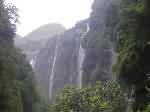
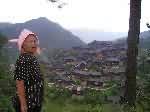
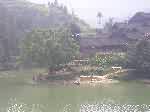
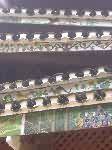
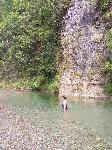
 Copyright © 1998-2026 All rights reserved.
Copyright © 1998-2026 All rights reserved.